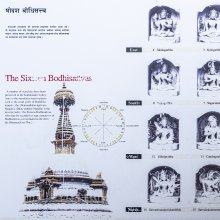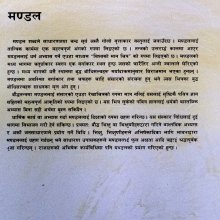Avasthita: 23 definitions
Introduction:
Avasthita means something in Buddhism, Pali, Hinduism, Sanskrit, Jainism, Prakrit, Marathi. If you want to know the exact meaning, history, etymology or English translation of this term then check out the descriptions on this page. Add your comment or reference to a book if you want to contribute to this summary article.
Images (photo gallery)
In Hinduism
Vyakarana (Sanskrit grammar)
Source: Wikisource: A dictionary of Sanskrit grammarAvasthita (अवस्थित).—Of a uniform nature; cf. सिद्धं त्ववस्थिता वर्णाः, वक्तुश्चिराचिरवचनाद् वृत्तयो विशिष्यन्ते (siddhaṃ tvavasthitā varṇāḥ, vaktuścirāciravacanād vṛttayo viśiṣyante), M. Bh. I.1.70 V. 5.

Vyakarana (व्याकरण, vyākaraṇa) refers to Sanskrit grammar and represents one of the six additional sciences (vedanga) to be studied along with the Vedas. Vyakarana concerns itself with the rules of Sanskrit grammar and linguistic analysis in order to establish the correct context of words and sentences.
Natyashastra (theatrics and dramaturgy)
Source: Wisdom Library: Nāṭya-śāstraAvasthita (अवस्थित, “unsteady”) refers to one of the “five faults” (doṣa) of a singer according to the Nāṭyaśāstra 32.519-525:—“when there is an irregular excess or want of volume in voice, it is called unsteady (avasthita). A lean voice is also given this name”.

Natyashastra (नाट्यशास्त्र, nāṭyaśāstra) refers to both the ancient Indian tradition (shastra) of performing arts, (natya—theatrics, drama, dance, music), as well as the name of a Sanskrit work dealing with these subjects. It also teaches the rules for composing Dramatic plays (nataka), construction and performance of Theater, and Poetic works (kavya).
Shaktism (Shakta philosophy)
Source: Google Books: Manthanabhairavatantram1) Avasthita (अवस्थित) refers to one “immersed” (in yoga—i.e., Viṣṇu), according to the second recension of the Yogakhaṇḍa of the Manthānabhairavatantra, a vast sprawling work that belongs to a corpus of Tantric texts concerned with the worship of the goddess Kubjikā.—Accordingly, “[...]Then when that goddess, who is the divine energy of nectar that rains down specks (of nectar) onto Himavat, meditated there, a drop of this nectar, which is the supreme energy, fell that very moment from the sky onto the earth. O Hara, thus the god who is Bhairava appeared. He is Śrīkaṇṭha, that is, Rudra, Maheśvara with one face. Viṣṇu, the Kaula immersed in Yoga [i.e., yoga-avasthita] looked (at the god who stood) in front (of him)”.
2) Avasthita (अवस्थित) refers to “one who is present within (...)”, according to the Devīpañcaśataka, an important source of the Kālīkrama that developed in Kashmir after the Kālī Mata of the Jayadrathayāmala.—Accordingly, “The Great God—Mahādeva—is beyond Śakti, supreme bliss, free of qualities and supports, unchanging, supreme, pure, free of cause and (without) example, present within all existing things, beyond the Void, free of defects, omnipresent, the doer of all things, free, full of nectar and, unconditioned, is present in all living beings [i.e., sarvabhūta-avasthita]. [...]”.

Shakta (शाक्त, śākta) or Shaktism (śāktism) represents a tradition of Hinduism where the Goddess (Devi) is revered and worshipped. Shakta literature includes a range of scriptures, including various Agamas and Tantras, although its roots may be traced back to the Vedas.
Purana and Itihasa (epic history)
Source: archive.org: Shiva Purana - English TranslationAvasthita (अवस्थित) refers to “meditation”, according to the Śivapurāṇa 2.3.18 (“Description of the perturbation caused by Kāma”).—Accordingly, as Brahmā narrated: “[...] In the mean time Pārvatī came there along with her two maids and brought various kinds of flowers for Śiva’s worship. Certainly Pārvatī had a greater beauty than the most exquisite lady described by people on the earth. When she wore pretty flowers of the season how could her beauty be described even in a hundred years? No sooner did she enter within the proximity of Śiva than He came out of his meditation for a short while [i.e., avasthita—kṣaṇamavasthitaḥ]. [...]”.

The Purana (पुराण, purāṇas) refers to Sanskrit literature preserving ancient India’s vast cultural history, including historical legends, religious ceremonies, various arts and sciences. The eighteen mahapuranas total over 400,000 shlokas (metrical couplets) and date to at least several centuries BCE.
Shaivism (Shaiva philosophy)
Source: Brill: Śaivism and the Tantric TraditionsAvasthita (अवस्थित) refers to “one who is stationed in” (the realm of akula), according to Jayaratha ad Nityāṣoḍaśikārṇava verse 4.14.—Accordingly, “Then leaving behind the kula, i.e. the body, she goes to the one who is in the realm of akula [i.e., avasthita—akulapadāvasthitaṃ], the supreme, i.e. full […] Person, the highest authority, who is without a body and without bodily form, with his innate nature manifest and therefore lacking qualities, i.e. she reaches oneness with Him. This is the meaning [of this verse]”.
Source: SOAS University of London: Protective Rites in the Netra TantraAvasthita (अवस्थित) refers to “(being) situated” (among all beings), according to the Svacchanda-tantra.—Accordingly, [verse 7.207]—“[The Yogin] dwells there [in breath]. He should impel all [creation], [and is] situated (avasthita) among all beings. After [he has] meditated upon [haṃsa], he conquers death. The powerful Lord does not create that which is not situated in kāla. For one engaged in meditation, after six months, omniscience arises. The knower of yoga is yoked with kāla. He recognizes three times [the past, present, and future]”.

Shaiva (शैव, śaiva) or Shaivism (śaivism) represents a tradition of Hinduism worshiping Shiva as the supreme being. Closely related to Shaktism, Shaiva literature includes a range of scriptures, including Tantras, while the root of this tradition may be traced back to the ancient Vedas.
Yoga (school of philosophy)
Source: ORA: Amanaska (king of all yogas): A Critical Edition and Annotated Translation by Jason BirchAvasthita (अवस्थित) refers to “being situated in” (the state of Rājayoga), according to the Yogatārāvalī: a short Yoga text of twenty-nine verses presenting Haṭhayoga as the means to Rājayoga (i.e., Samādhi).—Accordingly, while describing the states of waking, sleep, life and death: “For those [Yogins] situated in (avasthita) [the state of] Rājayoga whose gaze is free from all sense objects, here there is no waking, no state of sleep, no life, no death and no mind”.

Yoga is originally considered a branch of Hindu philosophy (astika), but both ancient and modern Yoga combine the physical, mental and spiritual. Yoga teaches various physical techniques also known as āsanas (postures), used for various purposes (eg., meditation, contemplation, relaxation).
In Buddhism
Mahayana (major branch of Buddhism)
Source: academia.edu: A Study and Translation of the GaganagañjaparipṛcchāAvasthita (अवस्थित) (Cf. Anavasthita) refers to “(that which has) basis”, according to the Gaganagañjaparipṛcchā: the eighth chapter of the Mahāsaṃnipāta (a collection of Mahāyāna Buddhist Sūtras).—Accordingly, “Son of good family, the morality of the Boddhisatvas becomes purified by these eight qualities. [...] Further, as for the purity of morality, [...] open space cannot be grasped, and also that morality cannot be grasped; open space has no basis (anavasthita-gagana—anavasthitaṃ gaganaṃ), and no basis has also that morality; open space is not non-existent, and not non-existent is also that morality; open space is permanent, and permanent is also that morality; open space is imperishable, and imperishable is also that morality; [...]”.
Source: De Gruyter: A Buddhist Ritual Manual on AgricultureAvasthita (अवस्थित) refers to “standing (visibly)” (in front of the Bhagavān), according to the Vajratuṇḍasamayakalparāja, an ancient Buddhist ritual manual on agriculture from the 5th-century (or earlier), containing various instructions for the Sangha to provide agriculture-related services to laypeople including rain-making, weather control and crop protection.—Accordingly, [as the Nāga-kings said to Bhagavān], “[...] O Bhagavān, when we all stand (avasthita) visibly in front of the Bhagavān, thus frightened and trembling, with the hairs on our bodies bristling, overcome with great dreadful fear, standing all with agitated minds, O Bhagavān, how will monks be in the last time, in the last age, after the Tathāgata has departed? [...]”.

Mahayana (महायान, mahāyāna) is a major branch of Buddhism focusing on the path of a Bodhisattva (spiritual aspirants/ enlightened beings). Extant literature is vast and primarely composed in the Sanskrit language. There are many sūtras of which some of the earliest are the various Prajñāpāramitā sūtras.
In Jainism
General definition (in Jainism)
Source: archive.org: TrisastisalakapurusacaritraAvasthita (अवस्थित) refers to “claivoyant knowledge that is constant and unfluctuating” and represents one of the six types of “clairvoyant knowledge of physical objects” (avadhi-jñāna) which itself refers to one of the five types of “right-knowledge” (samyagjñāna), as mentioned in chapter 1.3 [ādīśvara-caritra] of Hemacandra’s 11th century Triṣaṣṭiśalākāpuruṣacaritra: an ancient Sanskrit epic poem narrating the history and legends of sixty-three illustrious persons in Jainism.
Accordingly, as mentioned in Ṛṣabha’s sermon:
Source: Encyclopedia of Jainism: Tattvartha Sutra“[...] mokṣa is attained by those who practice unceasingly the brilliant triad of knowledge, faith, and conduct. Among these, exact knowledge which comes from a summary or detailed study of the principles, jīva, etc., is called ‘right-knowledge’ (samyagjñāna). [...] Avadhi-jñāna is innate to gods and hell-inhabitants. Of others it is six-fold [viz., avasthita], characterized by destruction and suppression”—(cf. Tattvārthādhigamasūtra 1.23 with commentary).
Avasthita (अवस्थित, “steady”) represents one of the six types of guṇapratyaya: a category of knowledge (jñāna) obtained by clairvoyance (avadhi-jñāna), according to Tattvārthasūtra 1.21.
What is meant by steady (avasthita) clairvoyance? It is the clairvoyant knowledge that neither increases nor decreases, i.e. remains steady.
Source: The University of Sydney: A study of the Twelve ReflectionsAvasthita (अवस्थित) refers to “(being) placed” (separately), according to the 11th century Jñānārṇava, a treatise on Jain Yoga in roughly 2200 Sanskrit verses composed by Śubhacandra.—Accordingly, “Also, fool, having passed beyond their own nature, all beings who reside in the three worlds exist separately (pṛthak pṛthag vyavasthitāḥ; var—pṛthag avasthitāḥ—“placed separately”) at all times”.

Jainism is an Indian religion of Dharma whose doctrine revolves around harmlessness (ahimsa) towards every living being. The two major branches (Digambara and Svetambara) of Jainism stimulate self-control (or, shramana, ‘self-reliance’) and spiritual development through a path of peace for the soul to progess to the ultimate goal.
Languages of India and abroad
Marathi-English dictionary
Source: DDSA: The Molesworth Marathi and English Dictionaryavasthita (अवस्थित).—p S Occupying place or time; being, staying, remaining, abiding; fixed, fast, firm, placed. 2 (Used ignorantly for akasmāta) Suddenly.
Source: DDSA: The Aryabhusan school dictionary, Marathi-Englishavasthita (अवस्थित).—p Fixed, remaining, abiding.
Marathi is an Indo-European language having over 70 million native speakers people in (predominantly) Maharashtra India. Marathi, like many other Indo-Aryan languages, evolved from early forms of Prakrit, which itself is a subset of Sanskrit, one of the most ancient languages of the world.
Sanskrit dictionary
Source: DDSA: The practical Sanskrit-English dictionaryAvasthita (अवस्थित).—p. p.
1) Remained, stayed; कथमियतं कालमवस्थिता मया विना भवती (kathamiyataṃ kālamavasthitā mayā vinā bhavatī) V.4; remaining, standing firm or fixed; staying, abiding, lasting &c.; R.6.19; एवमवस्थिते (evamavasthite) K.158 under these circumstances.
2) Firm of purpose, steady; रूपयौवनसम्पन्ना यस्मात्त्वमनवस्थिता (rūpayauvanasampannā yasmāttvamanavasthitā) Rām. 7.3.37. see अनवस्थित (anavasthita).
3) Engaged in prosecuting; following; abiding by; Manusmṛti 8.42, ज्ञानावस्थितचेतसः (jñānāvasthitacetasaḥ) Bhagavadgītā (Bombay) 4.23.
4) Resting with, dependent on; मयि सृष्टिर्हि लोकानां रक्षा युष्मास्ववस्थिता (mayi sṛṣṭirhi lokānāṃ rakṣā yuṣmāsvavasthitā) Kumārasambhava 2.28; K.344.
5) Settled, a matter of course; पितुरस्याः समीपनयनमवस्थितमेव (piturasyāḥ samīpanayanamavasthitameva) Ś.5.
6) Resolved; युद्धाय (yuddhāya) Pañcatantra (Bombay) 1.
7) Ready, alert; ते कपिं तं समासाद्य तोरणस्थमवस्थितम् (te kapiṃ taṃ samāsādya toraṇasthamavasthitam) Rām.5.43.27.
8) motionless (niśceṣṭa); अवस्थितमसंभ्रान्तम् (avasthitamasaṃbhrāntam) (mām) Rām.5.58.39.
9) Well-arranged; कपित्वमनवस्थितम् (kapitvamanavasthitam) Rām.5.55.15.
Source: Cologne Digital Sanskrit Dictionaries: Shabda-Sagara Sanskrit-English DictionaryAvasthita (अवस्थित).—mfn.
(-taḥ-tā-taṃ) 1. Occupying place or period, abiding, residing remaining firm or fixed, &c. 2. Firm of purpose, steady. 3. Engaged in, prosecuting, following. E. ava before sthā to stay, affix kta.
Source: Cologne Digital Sanskrit Dictionaries: Cappeller Sanskrit-English DictionaryAvasthita (अवस्थित).—[adjective] standing, posted; contained or remaining in, intent upon ([locative] or —°), keeping on, continuing ([instrumental] of an [abstract] or [nominative] of a [participle]), ready to ([dative]); fixed, settled, firm, steady, true; (thus) situated or circumstanced.
Source: Cologne Digital Sanskrit Dictionaries: Monier-Williams Sanskrit-English Dictionary1) Avasthita (अवस्थित):—[=ava-sthita] [from ava-sthā] mfn. standing near (sometimes with [accusative], e.g. [Harivaṃśa 14728; Rāmāyaṇa v, 73, 26]), placed, having its place or abode, [Āśvalāyana-śrauta-sūtra; Maitrī-upaniṣad; Mahābhārata, etc.], (with a [present participle]) continuing to do anything, [Rāmāyaṇa iii, 30, 19]
2) [from ava-sthita > ava-sthā] engaged in, prosecuting, following, practising (with [locative case] [Mahābhārata] si, 1228 [Manu-smṛti] etc. or in [compound] [Bhagavad-gītā iv, 23; Hitopadeśa])
3) [v.s. ...] obeying or following (the words or commands of; [locative case]), [Bhāgavata-purāṇa; Bhaṭṭi-kāvya]
4) [v.s. ...] giving one’s self up to (e.g. to compassion or pride), [Mahābhārata xii, 272; Rāmāyaṇa v, 58, 13]
5) [v.s. ...] contained in ([locative case]), [Manu-smṛti xii, 119; Bhagavad-gītā ix, 4 and xv, 11] : being incumbent upon ([locative case]), [Kumāra-sambhava ii, 28], ready for ([dative case]), [Pañcatantra], firm, fixed, determined, [Kaṭha-upaniṣad; Rāmāyaṇa] etc.
6) [v.s. ...] steady, trusty, to be relied on [Manu-smṛti vii, 60, etc.] (cf. an-av.)
Source: Cologne Digital Sanskrit Dictionaries: Yates Sanskrit-English DictionaryAvasthita (अवस्थित):—[ava-sthita] (taḥ-tā-taṃ) a. Occupying place, engaged in; firm.
Source: DDSA: Paia-sadda-mahannavo; a comprehensive Prakrit Hindi dictionary (S)Avasthita (अवस्थित) in the Sanskrit language is related to the Prakrit word: Avaṭṭhia.
[Sanskrit to German]
Sanskrit, also spelled संस्कृतम् (saṃskṛtam), is an ancient language of India commonly seen as the grandmother of the Indo-European language family (even English!). Closely allied with Prakrit and Pali, Sanskrit is more exhaustive in both grammar and terms and has the most extensive collection of literature in the world, greatly surpassing its sister-languages Greek and Latin.
Kannada-English dictionary
Source: Alar: Kannada-English corpusAvasthita (ಅವಸ್ಥಿತ):—
1) [noun] a place for dwelling; a house.
2) [noun] the place that is the natural environment to be in.
3) [noun] the place where something is or has been originated, developed, etc.
4) [noun] a following; the processes of studying; learning.
5) [noun] the state of being; existence.
Kannada is a Dravidian language (as opposed to the Indo-European language family) mainly spoken in the southwestern region of India.
Nepali dictionary
Source: unoes: Nepali-English DictionaryAvasthita (अवस्थित):—adj. 1. located; situated; 2. existing; 3. firm of purpose; steady;
Nepali is the primary language of the Nepalese people counting almost 20 million native speakers. The country of Nepal is situated in the Himalaya mountain range to the north of India.
See also (Relevant definitions)
Starts with: Avasthitaka, Avasthitamati.
Ends with: Abhyavasthita, Anavasthita, Avyavasthita, Deshakalavyavasthita, Dhyanavasthita, Duravasthita, Grihavasthita, Jnanavasthita, Niryantranapradeshavasthita, Padavasthita, Paryavasthita, Paryyavasthita, Pratyavasthita, Sahavasthita, Samavasthita, Shariravasthita, Suvyavasthita, Vyavasthita, Yamavasthita, Yogavasthita.
Full-text (+18): Avasthiti, Avatthia, Anavasthiti, Anavasthita, Paryavasthita, Duravasthita, Abhyavasthita, Anavasthitatva, Vyavasthitatva, Anavasthitacitta, Vyavasthitavishaya, Anavasthitacittatva, Avatthii, Vyavasthiti, Baddhavasthiti, Avatthiti, Avasthitamati, Avattitan, Jnanavasthita, Paryyavasthita.
Relevant text
Search found 21 books and stories containing Avasthita, Ava-sthita, Avasthiti; (plurals include: Avasthitas, sthitas, Avasthitis). You can also click to the full overview containing English textual excerpts. Below are direct links for the most relevant articles:
Tattvartha Sutra (with commentary) (by Vijay K. Jain)
Verse 5.4 - The special characteristics of substances < [Chapter 5 - The Non-living Substances]
Verse 1.22 - Clairvoyance due to destruction-cum-subsidence < [Chapter 1 - Right Faith and Knowledge]
Verse 5.5 - Things which have form constitute the matter (pudgala) < [Chapter 5 - The Non-living Substances]
Garga Samhita (English) (by Danavir Goswami)
Verses 5.7.16-17 < [Chapter 7 - The Killing of Kuvalayāpīḍa]
Verse 6.15.28 < [Chapter 15 - The Glories of Nṛga-kūpa and Gopī-bhūmi]
Verse 2.5.24 < [Chapter 5 - The Liberation of Bakāsura]
Shrimad Bhagavad-gita (by Narayana Gosvami)
Verse 15.11 < [Chapter 15 - Puruṣottama-toga (Yoga through understanding the Supreme Person)]
Verse 9.4 < [Chapter 9 - Rāja-guhya-yoga (Yoga through the most Confidential Knowledge)]
Verse 4.23 < [Chapter 4 - Jñāna-Yoga (Yoga through Transcendental Knowledge)]
Manusmriti with the Commentary of Medhatithi (by Ganganatha Jha)
Verse 7.114 < [Section X - Internal Administration]
Brihad Bhagavatamrita (commentary) (by Śrī Śrīmad Bhaktivedānta Nārāyana Gosvāmī Mahārāja)
Verse 1.5.86 < [Chapter 5 - Priya (the beloved devotees)]
Verse 2.4.255 < [Chapter 4 - Vaikuṇṭha (the spiritual world)]
Verse 1.3.85 < [Chapter 3 - Prapañcātīta (beyond the Material Plane)]
Rig Veda (translation and commentary) (by H. H. Wilson)
Rig Veda 1.142.10 < [Sukta 142]




